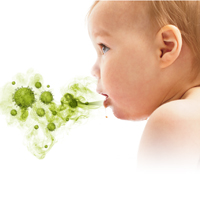Respiratory Syntactical Virus (RSV)
Respiratory syntactical virus (RSV) not only infects the lungs, but also the breathing passages. RSV is severe mainly in infants, small children, and older adults. People usually recover within 1 to 2 weeks, but for infants and small children RSV can last up to 3 weeks. Most children get infected by the age of 2.
RSV Symptoms
If your child is experiencing any of the following symptoms it is important for you to contact a doctor as soon as possible.
- High fever
- Thick nasal discharge
- Worsening cough or cough that produces yellow, green, or grey mucus

- Signs of dehydration
- Trouble breathing
- Breathing rapidly
- Is lethargic
- If lips or fingernails appear blue
For infants, besides the symptoms listed above, it is also important to contact a doctor if the infant is being irritable, inactive, refuses to breastfeed or bottle-feed.
How to prevent RSV
Although RSV is present year round, it starts to be more of a problem during the fall season, reaches its peak during the winter season, and starts to fade during the spring season. RSV can be transmitted easily. It can be transmitted through cough, sneezing, or even touching an infected person, for example shaking hands with a person with the infection. It can also live on surfaces that an infected person has touched. The best way to prevent from becoming infected is to practice good hygiene, washing hands, showering regularly, and cleaning off surfaces is great when trying to avoid infection. For infants it can also be prevented by receiving monthly vaccinations during it’s peak season which usually starts in November until April.



